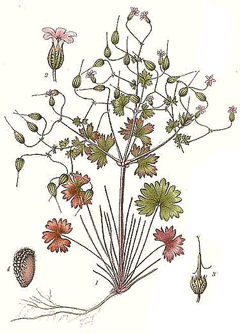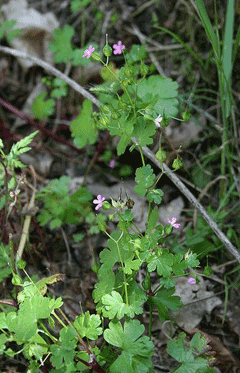 |
|
http://commons.wikimedia.org/wiki/File:217_Geranium_robertianum,_G._lucidum.jpg |
 |
| http://commons.wikimedia.org/wiki/User:Franz_Xaver |
Translate this page:
Summary
Physical Characteristics

 Geranium lucidum is a ANNUAL growing to 0.5 m (1ft 8in).
Geranium lucidum is a ANNUAL growing to 0.5 m (1ft 8in).
See above for USDA hardiness. It is hardy to UK zone 7. It is in flower from May to August. The species is hermaphrodite (has both male and female organs) and is pollinated by Insects.
Suitable for: light (sandy), medium (loamy) and heavy (clay) soils. Suitable pH: basic (mildly alkaline) soils. It cannot grow in the shade. It prefers dry or moist soil.
UK Hardiness Map
US Hardiness Map
Synonyms
Plant Habitats
Hedgerow; East Wall. In. South Wall. In. West Wall. In.
Edible Uses
References More on Edible Uses
Medicinal Uses
Plants For A Future can not take any responsibility for any adverse effects from the use of plants. Always seek advice from a professional before using a plant medicinally.
Astringent Diuretic
The plant is diuretic and astringent[240]. Other potential uses: Some sources mention its use for wound healing and other medicinal purposes.
References More on Medicinal Uses
The Bookshop: Edible Plant Books
Our Latest books on Perennial Plants For Food Forests and Permaculture Gardens in paperback or digital formats.

Edible Tropical Plants
Food Forest Plants for Hotter Conditions: 250+ Plants For Tropical Food Forests & Permaculture Gardens.
More

Edible Temperate Plants
Plants for Your Food Forest: 500 Plants for Temperate Food Forests & Permaculture Gardens.
More

More Books
PFAF have eight books available in paperback and digital formats. Browse the shop for more information.
Shop Now
Other Uses
A foodplant for the Annulet moth: The plant serves as a food source for the Annulet moth larvae. Groundcover: It can be used as a ground cover, providing a protective layer over the soil. Attracts wildlife: The plant can attract pollinators like bees and butterflies.
Special Uses
References More on Other Uses
Cultivation details
Succeeds in any moderately fertile retentive soil in a sunny position[200]. Most members of this genus tolerate a wide range of soil types[200], though this species is said to require a calcareous soil[17]. Members of this genus are rarely if ever troubled by browsing deer or rabbits[233].
References Carbon Farming Information and Carbon Sequestration Information
Temperature Converter
Type a value in the Celsius field to convert the value to Fahrenheit:
Fahrenheit:
The PFAF Bookshop
Plants For A Future have a number of books available in paperback and digital form. Book titles include Edible Plants, Edible Perennials, Edible Trees,Edible Shrubs, Woodland Gardening, and Temperate Food Forest Plants. Our new book is Food Forest Plants For Hotter Conditions (Tropical and Sub-Tropical).
Shop Now
Plant Propagation
Seed - sow spring in situ.
Other Names
If available other names are mentioned here
Native Range
TEMPERATE ASIA: Saudi Arabia, Cyprus, Iran, Iraq, Israel, Jordan, Lebanon, Syria, Turkey, Russian Federation-Ciscaucasia (Ciscaucasia), Armenia, Azerbaijan, Georgia, Russian Federation (Dagestan), Turkmenistan TROPICAL ASIA: India (Jammu and Kashmir), Nepal, Pakistan EUROPE: Denmark, Finland, United Kingdom, Ireland, Norway, Sweden, Austria, Belgium, Switzerland, Czech Republic, Germany, Hungary, Slovakia, Russian Federation-European part (European part (southeast)), Estonia, Latvia, Ukraine (incl. Krym), Albania, Bulgaria, Greece, Croatia, Italy (incl. Sardinia, Sicily), Romania, Serbia, Slovenia, Spain (incl. Baleares), France (incl. Corsica), Portugal AFRICA: Portugal (Madeira Islands), Algeria, Libya, Morocco, Tunisia
Weed Potential
Right plant wrong place. We are currently updating this section.
Please note that a plant may be invasive in one area but may not in your area so it's worth checking.
Geranium lucidum, also known as shiny geranium or shining cranesbill, is considered a weed or invasive in several regions, including parts of the United States, Canada, and Australia. Specifically, it's classified as an invasive species in parts of the US (like California, Washington, and Oregon) and Vancouver Island in Canada. It has also been introduced into Australia and New Zealand.
Invasive in specific regions: Geranium lucidum has become naturalized in areas of the United States, particularly in Washington, Oregon, and California. It's also present on Vancouver Island in Canada. Noxious weed designation: In Washington and Oregon, it's classified as a noxious weed, meaning it's regulated and its control is required. Ecological impacts: The plant can invade and overwhelm native habitats in forests and open grasslands. Introduced species: Geranium lucidum was introduced as a garden plant and has since escaped cultivation, becoming a problem in certain areas. Legislation and management: In Washington, regulations prohibit the transportation, sale, or distribution of the plant or its seeds.
Conservation Status
IUCN Red List of Threatened Plants Status :

| Related Plants
|
| Latin Name | Common Name | Habit | Height | Hardiness | Growth | Soil | Shade | Moisture | Edible | Medicinal | Other |
| Bauhinia purpurea | Orchid Tree, Purple Butterfly Tree, Mountain Ebony, Geranium Tree, Purple Bauhinia | Tree | 10.0 |
9-12
| F | LM | SN | M | 2 | 2 | 4 |
| Geranium bicknellii | Bicknell's cranesbill | Annual/Biennial | 0.6 |
0-0
| | LMH | N | M | 1 | 1 | |
| Geranium dissectum | Cut-Leafed Cranesbill, Cutleaf geranium | Annual | 0.6 |
6-9
| | LMH | N | M | 1 | 2 | 2 |
| Geranium erianthum | Wooly Geranium | Perennial | 0.3 |
3-7
| | LMH | SN | M | 1 | 1 | |
| Geranium incanum | Geranium, Cranesbill | Perennial | 0.4 |
4-9
| F | LMH | N | M | 1 | 0 | |
| Geranium macrorrhizum | Bigroot Geranium | Perennial | 0.5 |
4-8
| F | LMH | FSN | DM | 0 | 1 | 3 |
| Geranium maculatum | Spotted Cranesbill, Spotted geranium, Crowfoot, Wild Geranium, Cranesbill | Perennial | 0.6 |
3-10
| M | LMH | N | MWe | 0 | 3 | 2 |
| Geranium molle | Dovefoot Geranium | Annual | 0.4 |
-
| | LMH | N | DM | 0 | 1 | |
| Geranium nepalense | Nepalese Crane's Bill | Perennial | 1.0 |
6-9
| | LMH | N | M | 1 | 2 | 1 |
| Geranium ocellatum | | Annual | 0.3 |
-
| | LMH | N | M | 0 | 1 | |
| Geranium pilosum | | Perennial | 0.3 |
-
| | LMH | N | M | 1 | 0 | |
| Geranium potentilloides | Native Carrot, Cinquefoil geranium | Perennial | 0.6 |
0-0
| | LMH | N | M | 1 | 0 | |
| Geranium pratense | Meadow Crane's Bill, Meadow geranium, Geranium | Perennial | 1.2 |
5-9
| F | LMH | N | M | 0 | 2 | |
| Geranium pusillum | Small geranium | Perennial | 1.0 |
6-9
| | LMH | N | DM | 0 | 1 | |
| Geranium robertianum | Herb Robert, Robert geranium | Annual/Biennial | 0.4 |
5-9
| | LMH | SN | DM | 0 | 2 | 2 |
| Geranium rotundifolium | Roundleaf geranium | Annual | 0.4 |
6-9
| | LMH | N | M | 0 | 1 | |
| Geranium sibiricum | Siberian geranium | Perennial | 0.2 |
5-9
| | LMH | N | M | 0 | 1 | |
| Geranium solanderi | Solander's Geranium | Perennial | 0.6 |
-
| | LMH | N | M | 1 | 0 | |
| Geranium sylvaticum | Wood Cranesbill, Woodland geranium | Perennial | 1.0 |
4-8
| | LMH | FSN | M | 0 | 0 | 3 |
| Geranium thunbergii | Thunberg's geranium | Perennial | 0.3 |
6-9
| | LMH | N | M | 1 | 1 | |
| Geranium tuberosum | | Perennial | 0.3 |
7-10
| | LMH | N | M | 2 | 0 | |
| Geranium viscosissimum | Sticky Geranium, Sticky purple geranium | Perennial | 0.8 |
6-9
| | LMH | SN | M | 1 | 2 | |
| Geranium wallichianum | | Perennial | 0.3 |
6-9
| | LMH | SN | M | 0 | 2 | 3 |
| Geranium wilfordii | | Perennial | 0.6 |
-
| | LMH | SN | M | 0 | 2 | |
| Heuchera americana | Rock Geranium, American alumroot, Alumroot, Coral Bells, Rock Geranium | Perennial | 0.5 |
4-9
| M | LM | SN | M | 0 | 3 | 2 |
| Pelargonium australe | Ivy Geranium | Perennial | 0.3 |
8-11
| | LM | N | DM | 1 | 1 | |
| Pelargonium capitatum | Rose-Scented Geranium | Shrub | 0.6 |
8-11
| | LM | N | DM | 0 | 3 | 3 |
| Pelargonium crispum | Lemon Geranium | Shrub | 0.7 |
8-11
| | LM | SN | DM | 2 | 2 | 3 |
| Pelargonium exstipulatum | Pennyroyal Geranium | Shrub | 1.0 |
8-11
| | LM | N | DM | 1 | 2 | 2 |
|
|
Growth: S = slow M = medium F = fast. Soil: L = light (sandy) M = medium H = heavy (clay). pH: A = acid N = neutral B = basic (alkaline). Shade: F = full shade S = semi-shade N = no shade. Moisture: D = dry M = Moist We = wet Wa = water.
Now available:
Food Forest Plants for Mediterranean Conditions
350+ Perennial Plants For Mediterranean and Drier Food Forests and Permaculture Gardens.
[Paperback and eBook]
This is the third in Plants For A Future's series of plant guides for food forests tailored to
specific climate zones. Following volumes on temperate and tropical ecosystems, this book focuses
on species suited to Mediterranean conditions—regions with hot, dry summers and cool, wet winters,
often facing the added challenge of climate change.
Read More
Expert comment
Author
L.
Botanical References
17200
Links / References
For a list of references used on this page please go here
Readers comment